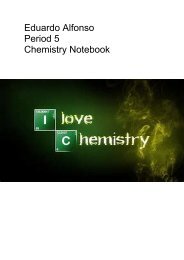Create successful ePaper yourself
Turn your PDF publications into a flip-book with our unique Google optimized e-Paper software.
Introduction to Organic Chemistry<br />
To understand life as we know it, we must first understand a little bit of organic chemistry. Organic<br />
molecules contain both carbon and hydrogen. Though many organic chemicals also contain other<br />
elements, it is the carbon-hydrogen bond that defines them as organic. Organic chemistry defines life.<br />
Just as there are millions of different types of living organisms on this planet, there are millions of<br />
different organic molecules, each with different chemical and physical properties. There are organic<br />
chemicals that make up your hair, your skin, your fingernails, and so on. The diversity of organic<br />
chemicals is due to the versatility of the carbon atom. Why is carbon such a special element? Let's<br />
look at its chemistry in a little more detail.<br />
The uniqueness of carbon<br />
Carbon (C) appears in the second row of the periodic table and has four bonding electrons in its<br />
valence shell (see our Periodic Table module for more information). Similar to other non-metals,<br />
carbon needs eight electrons to satisfy its valence shell. Carbon therefore forms four bonds with other<br />
atoms (each bond consisting of one of carbon's electrons and one of the bonding atom's electrons).<br />
Every valence electron participates in bonding; thus, a carbon atom's bonds will be distributed evenly<br />
over the atom's surface. These bonds form a tetrahedron (a pyramid with a spike at the top), as<br />
illustrated below:<br />
Carbon forms 4 bonds<br />
Organic chemicals get their diversity from the many different ways carbon can bond to other atoms.<br />
The simplest organic chemicals, called hydrocarbons, contain only carbon and hydrogen atoms; the<br />
simplest hydrocarbon (called methane) contains a single carbon atom bonded to four hydrogen<br />
atoms:<br />
Methane - a carbon atom bonded to 4 hydrogen atoms<br />
But carbon can bond to other carbon atoms in addition to hydrogen, as illustrated in the molecule<br />
ethane below:<br />
Ethane - a carbon-carbon bond<br />
In fact, the uniqueness of carbon comes from the fact that it can bond to itself in many different ways.<br />
Carbon atoms can form long chains:<br />
86



